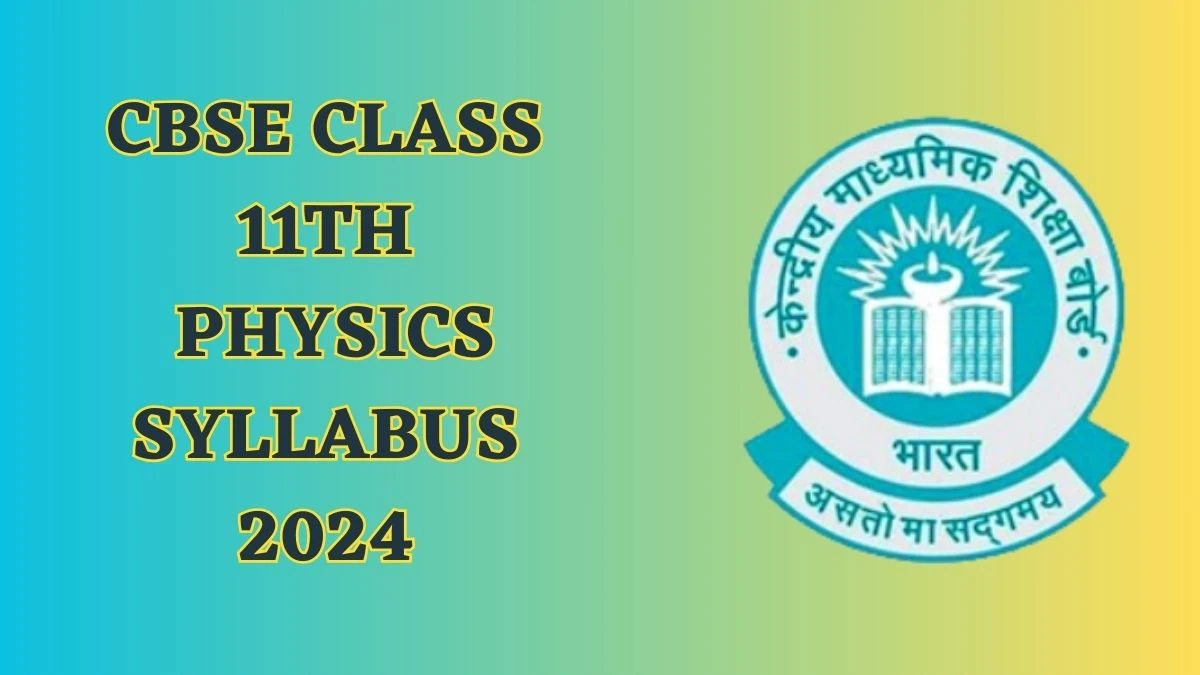- Rojgarlive »
- Education »
- CBSE Class 11th Physics Syllabus 2024 cbse.gov.in Download Pdf
CBSE Class 11th Physics Syllabus 2024 cbse.gov.in Download Pdf
by Sangeetha
Updated Apr 30, 2024

CBSE Class 11th Physics Syllabus 2024 @ cbse.gov.in
The Central Board of Secondary Education (CBSE) has recently unveiled the updated syllabus for CBSE 11th Physics in 2025. This syllabus is now accessible for download on the official CBSE website, cbse.gov.in.
The CBSE Class 11 Physics Syllabus for 2025 provides students with insight into crucial topics and the marking scheme for the 11th-grade Physics subject.
Check - CBSE Class 11th Physics Syllabus 2024
CBSE Class 11th Physics Syllabus 2024
|
Class 11 Physics chapters |
Topics |
|
Unit I: Physical World and Measurement |
|
|
Chapter–2: Units and Measurements |
Need for measurement: Units of measurement; systems of units; SI units, fundamental and derived units. significant figures. Dimensions of physical quantities, dimensional analysis and its applications. |
|
Unit II: Kinematics |
|
|
Chapter–3: Motion in a Straight Line |
Frame of reference, Motion in a straight line, Elementary concepts of differentiation and integration for describing motion, uniform and non-uniform motion, and instantaneous velocity, uniformly accelerated motion, velocity - time and position-time graphs. Relations for uniformly accelerated motion (graphical treatment). |
|
Chapter–4: Motion in a Plane |
Scalar and vector quantities; position and displacement vectors, general vectors and their notations; equality of vectors, multiplication of vectors by a real number; addition and subtraction of vectors, Unit vector; resolution of a vector in a plane, rectangular components, Scalar and Vector product of vectors. Motion in a plane, cases of uniform velocity and uniform accelerationprojectile motion, uniform circular motion. |
|
Unit III: Laws of Motion |
|
|
Chapter–5: Laws of Motion |
Intuitive concept of force, Inertia, Newton's first law of motion; momentum and Newton's second law of motion; impulse; Newton's third law of motion. Law of conservation of linear momentum and its applications. Equilibrium of concurrent forces, Static and kinetic friction, laws of friction, rolling friction, lubrication. Dynamics of uniform circular motion: Centripetal force, examples of circular motion (vehicle on a level circular road, vehicle on a banked road). |
|
Unit IV: Work, Energy, and Power |
|
|
Chapter–6: Work, Energy and Power |
Work done by a constant force and a variable force; kinetic energy, workenergy theorem, power. Notion of potential energy, potential energy of a spring, conservative forces: non- conservative forces, motion in a vertical circle; elastic and inelastic collisions in one and two dimensions. |
|
Unit V: Motion of System of Particles and Rigid Body |
|
|
Chapter–7: System of Particles and Rotational Motion |
Centre of mass of a two-particle system, momentum conservation and Centre of mass motion. Centre of mass of a rigid body; centre of mass of a uniform rod. Moment of a force, torque, angular momentum, law of conservation of angular momentum and its applications. Equilibrium of rigid bodies, rigid body rotation and equations of rotational motion, comparison of linear and rotational motions. Moment of inertia, radius of gyration, values of moments of inertia for simple geometrical objects (no derivation). |
|
Unit VI: Gravitation |
|
|
Chapter–8: Gravitation |
Kepler's laws of planetary motion, universal law of gravitation. Acceleration due to gravity and its variation with altitude and depth. Gravitational potential energy and gravitational potential, escape velocity, orbital velocity of a satellite. |
|
Unit VII: Properties of Bulk Matter |
|
|
Chapter–9: Mechanical Properties of Solids |
Elasticity, Stress-strain relationship, Hooke's law, Young’s modulus, bulk modulus, shear modulus of rigidity (qualitative idea only), Poisson's ratio; elastic energy. |
|
Chapter–10: Mechanical Properties of Fluids |
Pressure due to a fluid column; Pascal's law and its applications (hydraulic lift and hydraulic brakes), effect of gravity on fluid pressure. Viscosity, Stokes' law, terminal velocity, streamline and turbulent flow, critical velocity, Bernoulli's theorem and its simple applications. Surface energy and surface tension, angle of contact, excess of pressure across a curved surface, application of surface tension ideas to drops, bubbles and capillary rise. |
|
Chapter–11: Thermal Properties of Matter |
Heat, temperature, thermal expansion; thermal expansion of solids, liquids and gases, anomalous expansion of water; specific heat capacity; Cp, Cv - calorimetry; change of state - latent heat capacity. Heat transfer-conduction, convection and radiation, thermal conductivity, qualitative ideas of Blackbody radiation, Wein's displacement Law, Stefan's law . |
|
Unit VIII: Thermodynamics |
|
|
Chapter–12: Thermodynamics |
Thermal equilibrium and definition of temperature zeroth law of thermodynamics, heat, work and internal energy. First law of thermodynamics, Second law of thermodynamics: gaseous state of matter, change of condition of gaseous state -isothermal, adiabatic, reversible, irreversible, and cyclic processes. |
|
Unit IX: Behaviour of Perfect Gases and Kinetic Theory of Gases |
|
|
Chapter–13: Kinetic Theory |
Equation of state of a perfect gas, work done in compressing a gas. Kinetic theory of gases - assumptions, concept of pressure. Kinetic interpretation of temperature; rms speed of gas molecules; degrees of freedom, law of equi-partition of energy (statement only) and application to specific heat capacities of gases; concept of mean free path, Avogadro's number. |
|
Unit X: Oscillations and Waves |
|
|
Chapter–14: Oscillations |
Periodic motion - time period, frequency, displacement as a function of time, periodic functions and their application. Simple harmonic motion (S.H.M) and its equations of motion; phase; oscillations of a loaded spring- restoring force and force constant; energy in S.H.M. Kinetic and potential energies; simple pendulum derivation of expression for its time period. |
|
Chapter–15: Waves |
Wave motion: Transverse and longitudinal waves, speed of travelling wave, displacement relation for a progressive wave, principle of superposition of waves, reflection of waves, standing waves in strings and organ pipes, fundamental mode and harmonics, Beats. |
CBSE Class 11th Physics Syllabus 2024 - FAQs
Yes, the CBSE syllabus for Class 11 is designed in a way that students can also refer to the same for preparing for the exam such as NEET, JEE Main, etc.
Yes, NCERT syllabus is sufficient for the CBSE Class 11 exam preparation. However, students can also refer to some reference books.




